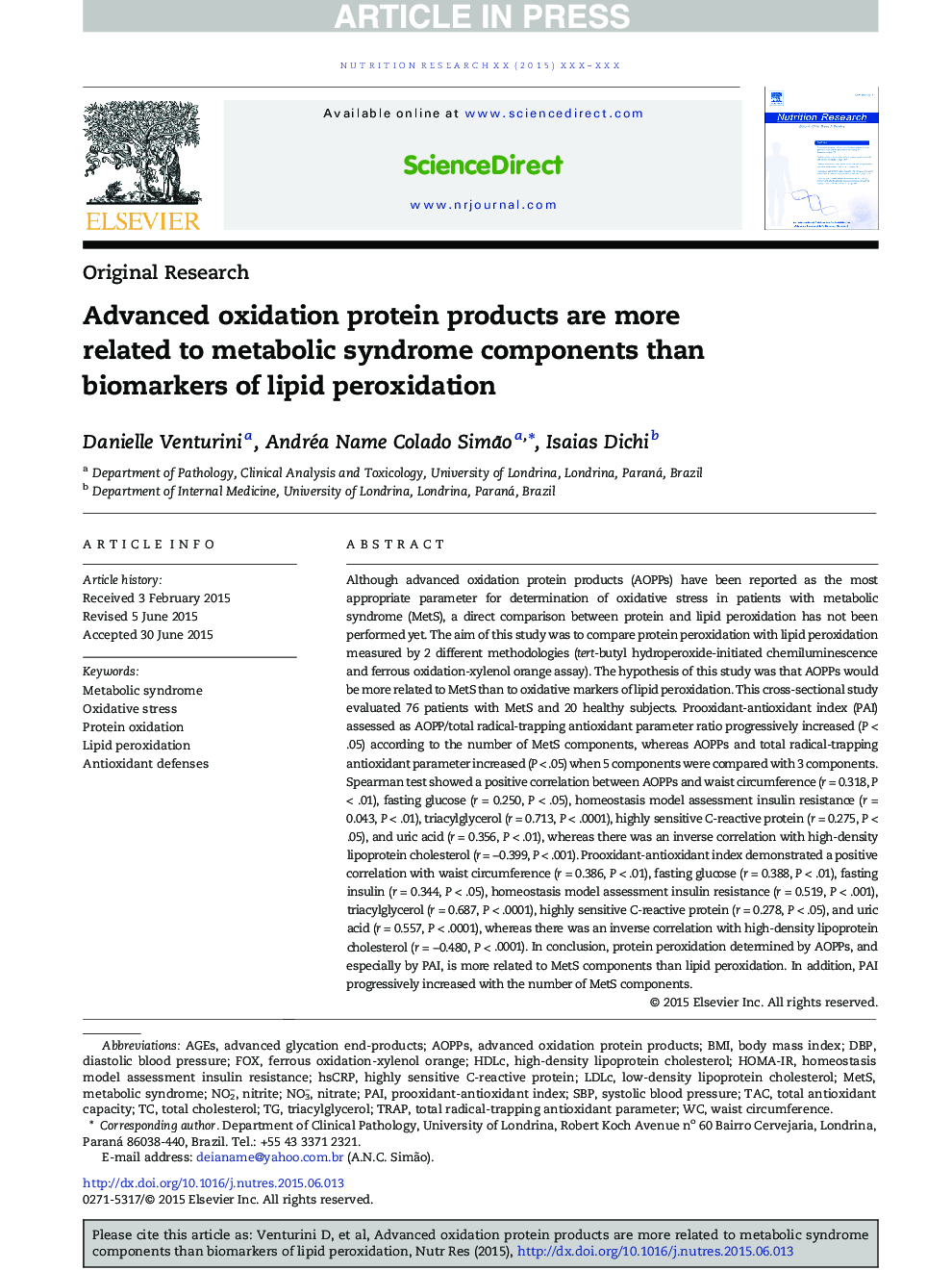| Article ID | Journal | Published Year | Pages | File Type |
|---|---|---|---|---|
| 5904418 | Nutrition Research | 2015 | 7 Pages |
Abstract
Although advanced oxidation protein products (AOPPs) have been reported as the most appropriate parameter for determination of oxidative stress in patients with metabolic syndrome (MetS), a direct comparison between protein and lipid peroxidation has not been performed yet. The aim of this study was to compare protein peroxidation with lipid peroxidation measured by 2 different methodologies (tert-butyl hydroperoxide-initiated chemiluminescence and ferrous oxidation-xylenol orange assay). The hypothesis of this study was that AOPPs would be more related to MetS than to oxidative markers of lipid peroxidation. This cross-sectional study evaluated 76 patients with MetS and 20 healthy subjects. Prooxidant-antioxidant index (PAI) assessed as AOPP/total radical-trapping antioxidant parameter ratio progressively increased (P < .05) according to the number of MetS components, whereas AOPPs and total radical-trapping antioxidant parameter increased (P < .05) when 5 components were compared with 3 components. Spearman test showed a positive correlation between AOPPs and waist circumference (r = 0.318, P < .01), fasting glucose (r = 0.250, P < .05), homeostasis model assessment insulin resistance (r = 0.043, P < .01), triacylglycerol (r = 0.713, P < .0001), highly sensitive C-reactive protein (r = 0.275, P < .05), and uric acid (r = 0.356, P < .01), whereas there was an inverse correlation with high-density lipoprotein cholesterol (r = â0.399, P < .001). Prooxidant-antioxidant index demonstrated a positive correlation with waist circumference (r = 0.386, P < .01), fasting glucose (r = 0.388, P < .01), fasting insulin (r = 0.344, P < .05), homeostasis model assessment insulin resistance (r = 0.519, P < .001), triacylglycerol (r = 0.687, P < .0001), highly sensitive C-reactive protein (r = 0.278, P < .05), and uric acid (r = 0.557, P < .0001), whereas there was an inverse correlation with high-density lipoprotein cholesterol (r = â0.480, P < .0001). In conclusion, protein peroxidation determined by AOPPs, and especially by PAI, is more related to MetS components than lipid peroxidation. In addition, PAI progressively increased with the number of MetS components.
Keywords
HOMA-IRTotal radical-trapping antioxidant parameterHighly Sensitive C-Reactive ProteinFOXLDLchsCRPHDLCTRAPAGEsTACDBPSBPAOPPsNO2−NO3−Protein oxidationPAItriacylglycerolOxidative stressAntioxidant defensesWaist circumferenceMetabolic syndromebody mass indexBMITotal antioxidant capacitydiastolic blood pressuresystolic blood pressurehigh-density lipoprotein cholesterolMETSadvanced glycation end-productsadvanced oxidation protein productsNitrateNitriteLipid peroxidationtotal cholesterolLow-density lipoprotein cholesterol
Related Topics
Life Sciences
Biochemistry, Genetics and Molecular Biology
Endocrinology
Authors
Danielle Venturini, Andréa Name Colado Simão, Isaias Dichi,
